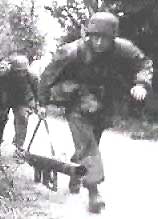|
|
|
|
Products mentioned in this Article
--None--
|
|
|
|
|
|
|
|
|
 |
|
|
|

Raketenpanzerbüchse 43
|
The Panzerschreck
The Panzerschreck is a classic case of the Germans seeing a good idea and improving on it.
|
|
In early 1943 the Germans captured their first
US Bazookas in Tunisia and quickly rushed them back to Germany for
investigation and testing. They liked what they saw and immediately started work on their own version.
It was decided to make the calibre 8.8cm rather
than the 6cm of the Bazooka, which made both the projectile and the
weapon heavier than the Bazooka, but gave it more punch.
|

Raketenpanzerbüchse 54
|
|

|
The new weapon
was designated the Raketenpanzerbüchse ("Rocket Tank Rifle") usually
abbreviated RPzB.
It was commonly called the Panzerschreck ("Tank Terror") and was also nicknamed Ofenrohr ("stove pipe") by the troops who used it.
Much of its design and mechanisms were very similar to the Bazooka. The major difference being it’s heavier round. The tube itself was 164cm long and weighed 9.25kgs unloaded. The round was the RPzB.Gr. 4322 (Raketenpanzerbüchsen-Granate/"Rocket Tank Rifle Grenade") with a shaped charge warhead of 660g and weighed 3.30kg. This first model was built in small number and was designated the Raketenpanzerbüchse 43.
One of its early problems was a reluctance by troops to use it, as their face was likely to be peppered with propellant particles as the rocket left the tube and continued to burn for further 2 meters.
|
|
The initial remedy was to issue the firer with a protective smock and a gas mask. A frontline user of the weapon submitted a suggestion to add a shield to protect the firer. The shield was incorporated in to the next model, Raketenpanzerbüchse 54 (RPzB.54). One unfortunate side effect of the new safety feature was it now gave this supposedly recoilless weapon a recoil when the rocket back blast hit the shield on exiting the tube.
The new model went into production in October 1943. It was slightly heavier at 11kgs unloaded and a new round was also introduced at the same time with improved performance. The new RPzB.Gr. 4992 rocket could penetrate up to 230mm of armour and was sighted up to 180m.
|
Last Updated On Friday, August 22, 2008 by Wayne at Battlefront
|
|
|